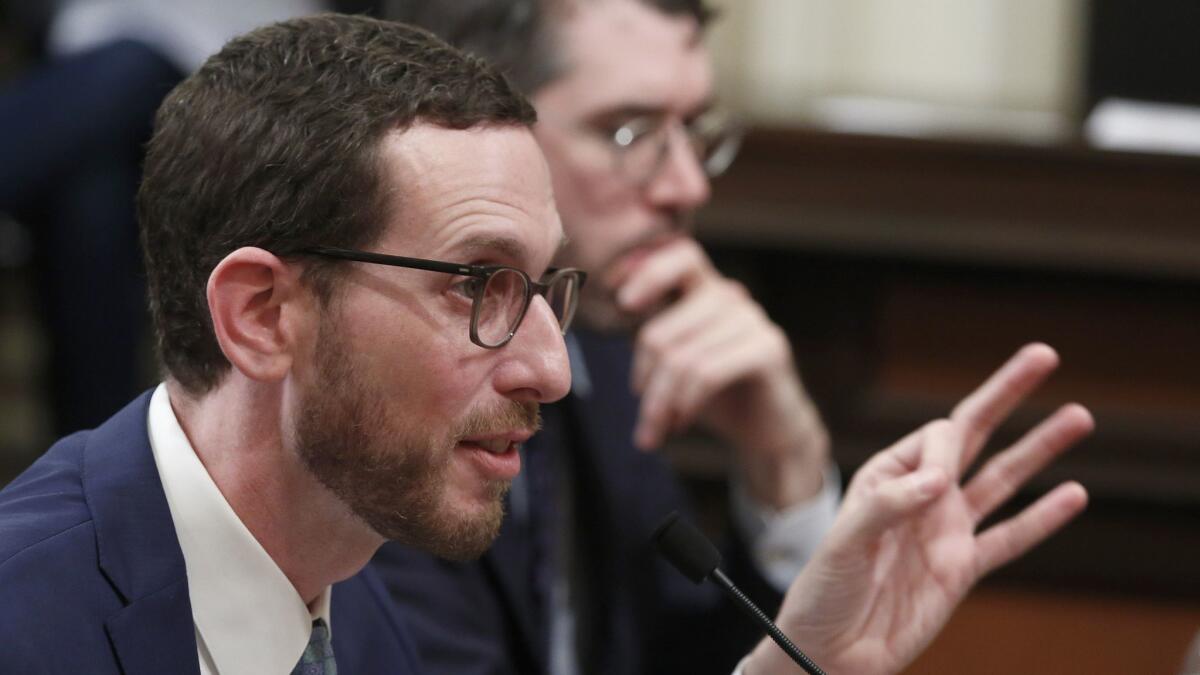California lawmaker again taking aim at single-family zoning

- Share via
SACRAMENTO — California lawmakers will once again debate a contentious measure that could radically increase housing growth in the state after a legislator revamped his proposal to allow construction of mid-rise apartment complexes near transit and fourplexes in single-family neighborhoods.
New changes to Senate Bill 50 introduced Monday would give cities and counties two years to develop plans to boost development in their communities before state mandates for greater housing density take effect. Sen. Scott Wiener (D-San Francisco), the bill’s author, said many local government officials told him they supported more housing in their cities but wanted more control over where it would be built.
“They want to be able to have some flexibility to increase the density in their community in their own way,” Wiener said.
Wiener’s changes to SB 50 come just weeks before a Jan. 31 deadline for the measure to pass the state Senate, required after the bill was held in a legislative committee last spring. The bill and its narrow time frame to advance are likely to reignite a clash between state and local officials and neighborhood activists over the future of development in California. The deadline also increases pressure on Gov. Gavin Newsom and Senate President Pro Tem Toni Atkins (D-San Diego), both of whom largely stayed out of last year’s fight over the bill, to weigh in more strongly on the measure.
Under SB 50, communities across California would see increased housing growth with the greatest effects expected in Los Angeles, the Bay Area, Silicon Valley and other densely populated areas. Lower-density neighborhoods would be forced to allow four- to five-story apartment buildings near rail lines, and smaller apartments and townhomes in wealthy areas near job centers. Increases to building heights and densities would be less dramatic in smaller counties, including Marin, Sonoma and Santa Barbara, and neighborhoods across the state at risk of gentrification will have five years — rather than two — to develop their own development blueprints.
This is the third year in a row that Wiener has tried to pass a bill to substantially boost growth in already developed communities, a move he argues is essential to addressing the state’s housing affordability challenges and reducing Californians’ reliance on cars in order to help reduce greenhouse gas emissions. The state’s median home value is $555,000, according to real estate website Zillow, more than twice the national average. And half to three-quarters of the developable land in much of the state is zoned for single-family housing, according to a 2018 survey by UC Berkeley’s Terner Center for Housing Innovation, making denser growth off-limits there — aside from garage conversions or backyard units.
Wiener’s previous attempts failed when groups representing lower-income communities of color argued that his bills would exacerbate displacement of residents, and activists from suburbs across the state contended the measure was a threat to the character of their neighborhoods.
The changes Wiener introduced Monday aim to undercut a key argument made by opponents: that local governments — not the state — should have control over development in their communities.
The new version of the bill would allow cities and counties to come up with their own plans to increase growth around transit and jobs as long as they boost density to the level required under SB 50. For example, a city could zone for six-story apartment complexes on a street next to a rail station and four-story complexes one street over rather than allowing five-story buildings on both. The provision allowing for fourplexes on single-family parcels would apply without exception.
Cities and counties already face existing state mandates to zone for significantly more housing within their boundaries.
In Southern California, communities in Los Angeles, Orange, Imperial, Riverside, San Bernardino and Ventura counties will soon have to set aside enough land to accommodate 1.3 million new homes, with the growth concentrated in coastal job centers. Wiener said his bill would complement those requirements, allowing cities to write their plans to meet existing state guidelines and the provisions in SB 50.
“SB 50 will be extremely helpful to cities that are seeing a big increase in their housing goals,” he said.
Still, like the existing state rules, SB 50 gives California housing officials the final say in determining whether local proposals meet the goals outlined in the bill. If city and county efforts are rejected, state density requirements would take effect.
It’s unclear if Wiener’s legislation will receive sufficient support in the Senate, particularly among fellow Democrats who were among the most hostile to the plan. In 2019, Sen. Anthony Portantino (D-La Cañada Flintridge) was the principal architect of the bill’s defeat, shelving it without a public vote in the Appropriations Committee, which he chairs. On Monday afternoon, Portantino said he hadn’t seen Wiener’s changes to the bill but said he remained concerned that the bill would prioritize market-rate housing instead of low-income development and do so without ensuring that new streets, sidewalks and other new infrastructure would come alongside the homebuilding.
“This bill doesn’t build affordable housing,” Portantino said. “I prefer to actually fund affordable housing.”
Atkins, who deferred to Portantino’s decision to shelve the bill last year, has since said she would work on SB 50 in 2020. In an interview Monday, Atkins said she expected SB 50 to advance out of the Appropriations Committee for a Senate floor vote this month.
“That’s the goal,” she said.
Though Newsom has not taken a position on SB 50, the governor said he was “disappointed” after the bill was held last year and signaled he’d back efforts to take power from city and county officials to increase density.
“The governor remains focused as a top priority on getting more housing built all across the state, for people at all income levels,” Newsom spokesman Jesse Melgar said in a statement on Monday.
In a sign of how strong passions are surrounding SB 50, local government officials again lined up in recent weeks to announce their stances on the bill even before Wiener unveiled his changes. Last month, the Santa Clara County Board of Supervisors voted to support the bill, contending that the state should help stimulate housing construction in Silicon Valley.
Officials in Wiener’s home city of San Francisco, however, voted in December to oppose the lawmaker’s housing density bills for the third time. Supervisor Gordon Mar, who spearheaded a recent resolution against SB 50, said the city needed to send a clear message that the bill would cause harm if it did not increase requirements for developers to build low-income housing alongside greater density.
“I think the kind of upzoning that SB 50 would mandate especially in a hot market city like San Francisco would immediately increase value of properties without requiring additional commitments to provide affordable housing or community benefits,” Mar said. “It’s essentially a giveaway to developers.”
As it stands, Wiener’s bill would require projects larger than 10 units to contribute funding or space for low-income housing. Developers who hope to take advantage of SB 50 also would be prohibited from demolishing homes on properties where tenants have lived for at least seven years. Another change introduced Monday would give low-income residents living in neighborhoods near projects built under SB 50 a preference in moving into the new units. The senator says he remains in negotiations with a coalition of groups representing low-income communities about further changes to the bill.
The Los Angeles City Council opposed both prior versions of Wiener’s bill, expressing concerns about its effects on single-family neighborhoods, historic districts and gentrifying communities. Mayor Eric Garcetti was against Wiener’s first effort but did not take a position on SB 50 last year.
More to Read
Sign up for Essential California
The most important California stories and recommendations in your inbox every morning.
You may occasionally receive promotional content from the Los Angeles Times.











